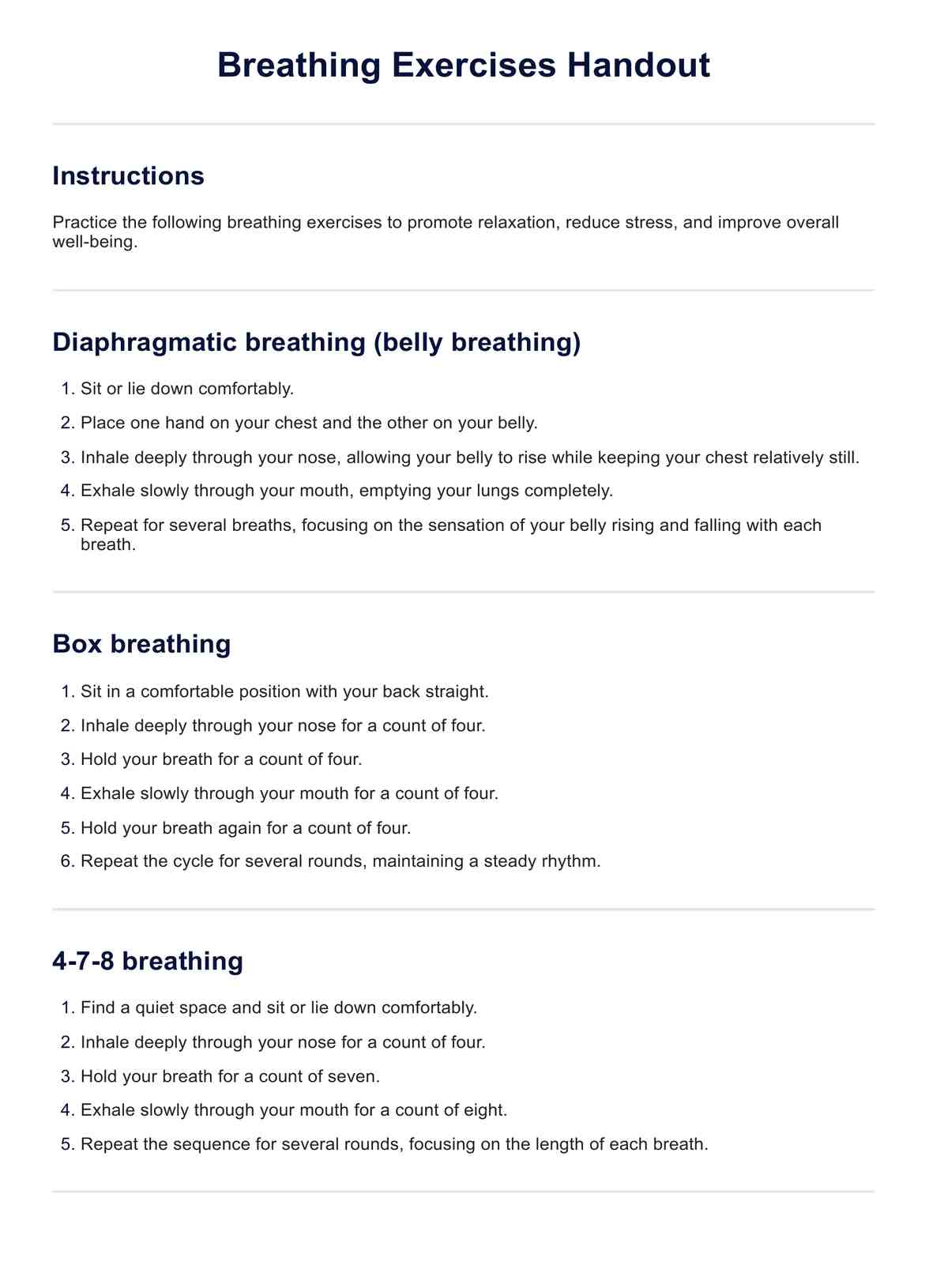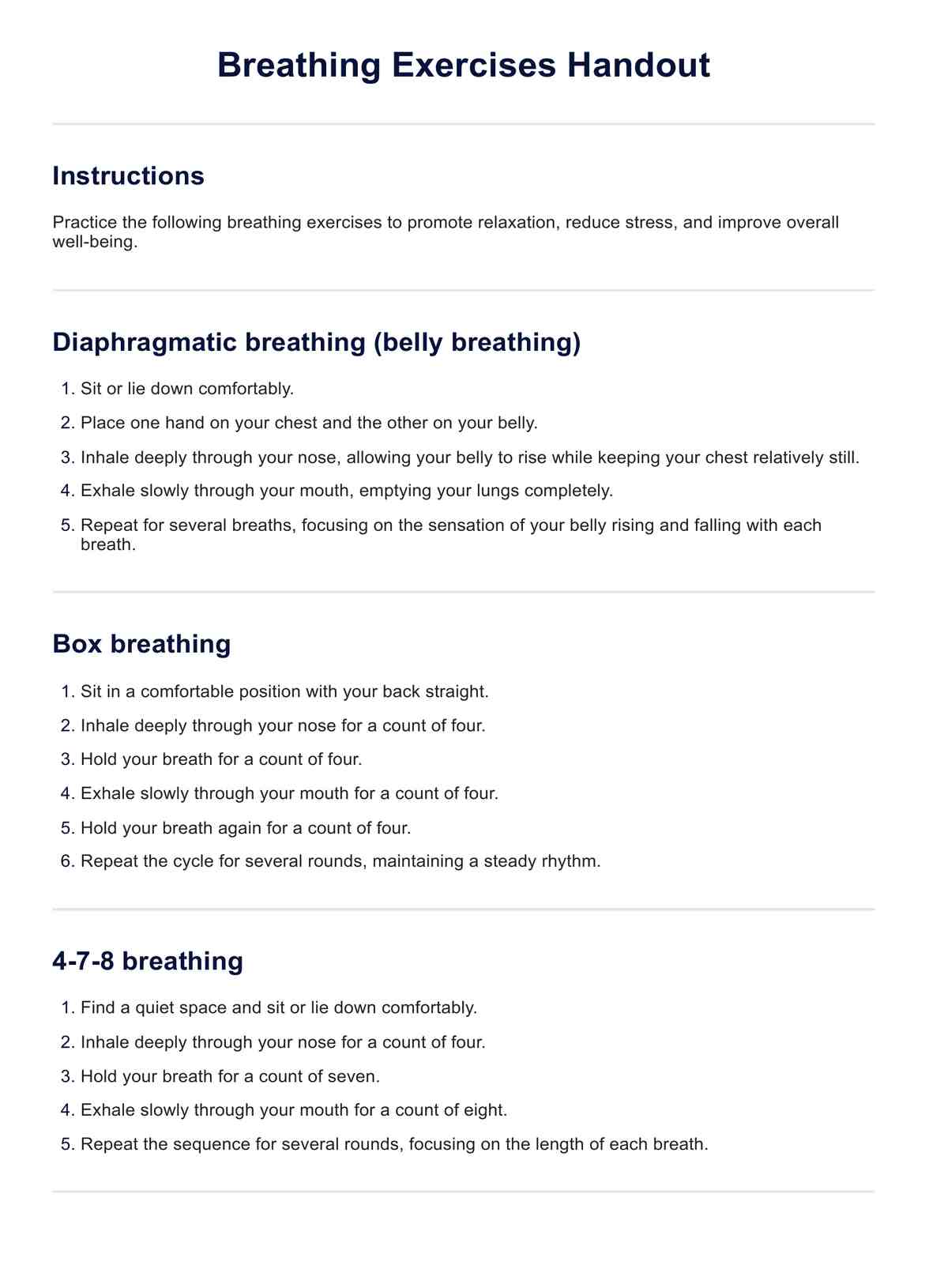Printable Breathing Exercises Handout
Improve mental and physical well-being with printable breathing exercises. Download Carepatron's free PDF handout to help your client relax and reduce stress.


What are breathing exercises?
Breathing exercises offer a multitude of benefits that cater to both physical and mental well-being. They encompass various techniques such as deep breathing exercises, yoga breathing exercises, and diaphragmatic breathing. These techniques promote relaxation, reduce stress, and enhance overall health.
Practicing deep breathing can significantly impact social-emotional learning by fostering self-regulation and providing practical coping skills. By incorporating breathing exercises into daily routines, individuals can experience moments of calm amidst life's chaos. Moreover, deep breaths can serve as valuable brain breaks, allowing individuals to reset and refocus during demanding situations.
Belly breathing, another term for diaphragmatic breathing, involves inhaling deeply, allowing the belly to expand, and exhaling slowly. This technique helps individuals engage their diaphragm fully, promoting relaxation and reducing tension in the body.
Healthcare practitioners often teach deep breathing to their patients as a fundamental self-care practice. Whether it's to alleviate anxiety, manage pain, or simply unwind after a long day, integrating breathing exercises into one's routine can benefit the body and mind.
Printable Breathing Exercises Handout Template
Printable Breathing Exercises Handout Example
Examples of breathing exercises
Breathing exercises offer a variety of techniques to promote relaxation, reduce stress, and improve overall well-being. Below are seven examples of breathing exercises that individuals of all ages can incorporate into their daily routines:
Diaphragmatic breathing
Diaphragmatic breathing, also known as belly breathing, involves inhaling deeply through the nose, allowing the belly to rise, and exhaling slowly through the mouth. This technique fully engages the diaphragm, promoting relaxation and reducing tension in the body.
Box breathing
Box breathing, a technique commonly used by military personnel and athletes, involves inhaling deeply for a count of four, holding the breath for a count of four, exhaling for a count of four, and holding the breath again for a count of four. This rhythmic pattern helps calm the mind and regulate breathing.
4-7-8 breathing
In 4-7-8 breathing, individuals inhale deeply through the nose for a count of four, hold the breath for seven, and exhale slowly through the mouth for a count of eight. This exercise promotes relaxation and can help alleviate anxiety and stress.
Alternate nostril breathing
Alternate nostril breathing involves closing one nostril with a finger and inhaling deeply through the other nostril. Then, the individual alternates by closing the opposite nostril and exhaling through the open nostril. This practice balances energy levels and promotes mental clarity.
Lion's breath
Lion's breath is a yoga breathing exercise that involves inhaling deeply through the nose and then exhaling forcefully through the mouth while sticking out the tongue and making a roaring sound. This playful exercise helps release tension in the face and throat.
Square breathing
Similar to box breathing, square breathing follows a four-step pattern. Individuals inhale deeply for a count of four, hold their breath for a count of four, exhale for a count of four, and then hold their breath again for a count of four. This technique promotes relaxation and mindfulness.
Straw breathing
Straw breathing involves inhaling slowly through a straw and then exhaling gently through the same straw. This exercise helps regulate breathing and can be especially beneficial for children learning to control their breath.
How to use our Printable Breathing Exercises template
Carepatron's Printable Breathing Exercises template provides a convenient tool for medical practitioners to integrate deep breathing techniques into their practice. Below are the steps on how to effectively utilize the template:
Step 1. Access the template
Begin by accessing the Printable Breathing Exercises template provided by Carepatron. This template is available for download on our platform and can be easily accessed by registered users.
Step 2. Introduce the exercises
Introduce the breathing exercises to your patients or clients during sessions. Provide clear instructions on how to perform each exercise, emphasizing the importance of deep breathing, relaxation, and mindfulness.
Step 4. Demonstrate techniques
Demonstrate the breathing techniques to your patients or clients to ensure they understand the correct methods. Encourage them to practice deep breathing, engage their diaphragm, and focus on slow, rhythmic breaths.
Step 5. Incorporate into routine
Encourage patients or clients to incorporate the breathing exercises into their daily routine. Suggest using the template as part of a calming corner or coping strategies toolkit to reduce anxiety and promote emotional regulation.
Step 6. Provide feedback and adjustments
Provide feedback and adjust the breathing exercises as needed. Offer guidance on overcoming challenges and adapting the techniques to suit individual preferences and needs better.
Commonly asked questions
Diaphragmatic or belly breathing is considered one of the best exercises for improving breathing efficiency and promoting relaxation. It involves taking deep breaths that fully engage the diaphragm, reducing stress and enhancing overall lung function.
To correct your breathing, focus on taking slow, deep breaths through your nose, allowing your diaphragm to expand and your belly to rise. Exhale slowly through your mouth, ensuring a steady and controlled air release.
The healthiest breathing technique is deep, diaphragmatic breathing, which promotes optimal oxygen exchange and reduces tension. Practicing mindfulness while breathing can further enhance its benefits for physical and mental health.




















-template.jpg)



















































































